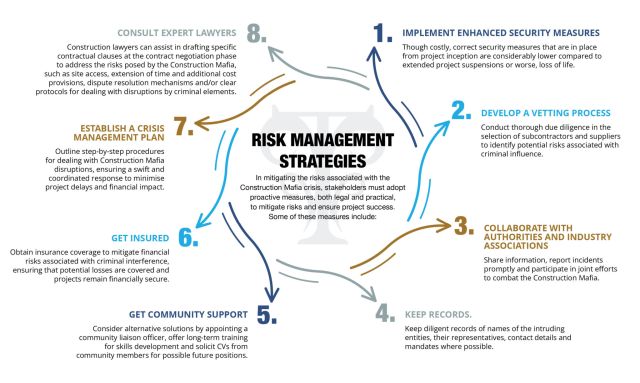South Africa's construction industry has long been a crucial driver of economic growth and development. In recent years, however, the sector has faced a significant challenge in the form of the Construction Mafia crisis. This issue, characterised by criminal elements infiltrating construction projects, has far-reaching implications for contract obligations, service delivery and overall project success. What effect has the Construction Mafia crisis had on the South African construction industry, particularly its impact on contract obligations and the delivery of contracted services? What steps should stakeholders take to mitigate their risks?
One notable aspect of the Construction Mafia is its lack of a single, unified organisation. Instead, it consists of independent syndicates, often operating regionally and exploiting their connections with local authorities. These syndicates usually comprise individuals with some level of experience in the construction industry and employ a modus operandi involving extortion, racketeering, violence, intimidation, and disruption – tactics used to achieve their objectives. The obscure nature of these groups makes them a formidable challenge for the construction industry and law enforcement.
Financial gain and self-enrichment drive these syndicates, leading to project delays, increased construction costs, and a deterioration of infrastructure. The repercussions extend beyond individual businesses, affecting local communities and deterring potential investors.
The Construction Mafia has disrupted the traditional dynamics of construction contracts in South Africa. Contractors are now confronted with an additional layer of complexity as they grapple with the influence of criminals seeking to extort money, control labour forces and manipulate project outcomes. This has led to increased uncertainty in fulfilling contract obligations as contractors must navigate not only legal and contractual requirements but also the demands and threats imposed by these criminal elements.
In some instances, the Construction Mafia has interfered with the selection of subcontractors and suppliers, leading to compromised quality and delayed project timelines. These interferences pose challenges to meeting milestones and completion deadlines. As a result, contractors find themselves in a precarious position, caught between honouring their contractual commitments and dealing with the illicit pressures imposed by the Construction Mafia.
The Construction Mafia disrupts contractors' ability to deliver contracted services timeously and often leads to projects having to be suspended for extended periods. This in turn leads to increased costs, reduced investor confidence, potential job losses and a negative ripple effect on the broader economy.
Various contract types, such as fixed-price contracts and cost-plus contracts are susceptible to different risks posed by the Construction Mafia crisis. Fixed-price contracts may face challenges in absorbing unforeseen costs arising from criminal interference, leading to financial strain on contractors. On the other hand, cost-plus contracts may see increased costs due to the need for enhanced security measures and the potential loss of productivity caused by criminal disruptions.
In mitigating the risks associated with the Construction Mafia crisis, stakeholders must adopt proactive measures, both legal and practical, to mitigate risks and ensure project success. Some of these measures include:
- Implementing enhanced security measures to safeguard construction sites and personnel against criminal interference. Although costly, if the correct security measures are in place from project inception, the costs thereof compared with extended project suspensions or even worse, loss of life, are minimal.
- Developing a vetting process and conducting thorough due diligence in the selection of subcontractors and suppliers to identify potential risks associated with criminal influence.
- Collaborating with relevant authorities and industry associations by sharing information, reporting incidents promptly and participating in joint efforts to combat the Construction Mafia.
- Keeping diligent records of names of the intruding entities, their representatives, contact details and requesting their mandates, if possible.
- Offering an alternative solution by appointing a community liaison officer, offering long-term training for skills development and soliciting resumes from community members for possible future positions.
- Obtaining insurance coverage to mitigate financial risks associated with criminal interference, ensuring that potential losses are covered and projects remain financially secure.
- Establishing a crisis management plan that outlines step-by-step procedures for dealing with Construction Mafia disruptions, ensuring a swift and coordinated response to minimise project delays and financial impact.
- Consulting construction lawyers to assist in drafting specific contractual clauses at the contract negotiation phase to address the risks posed by the Construction Mafia. These may involve site access, extension of time and additional cost provisions, dispute resolution mechanisms and/or clear protocols for dealing with disruptions by criminal elements.

Addressing the challenges posed by the Construction Mafia is a complex and ongoing process. To effectively tackle this issue government bodies, construction companies, regulatory agencies and the public, must come together and implement multifaceted, proactive strategies.
Although not an easy fix, by adopting a comprehensive and persistent approach, the industry can work towards eliminating corruption, ensuring fair competition and the sustained growth and integrity of the construction sector.
The content of this article is intended to provide a general guide to the subject matter. Specialist advice should be sought about your specific circumstances.
